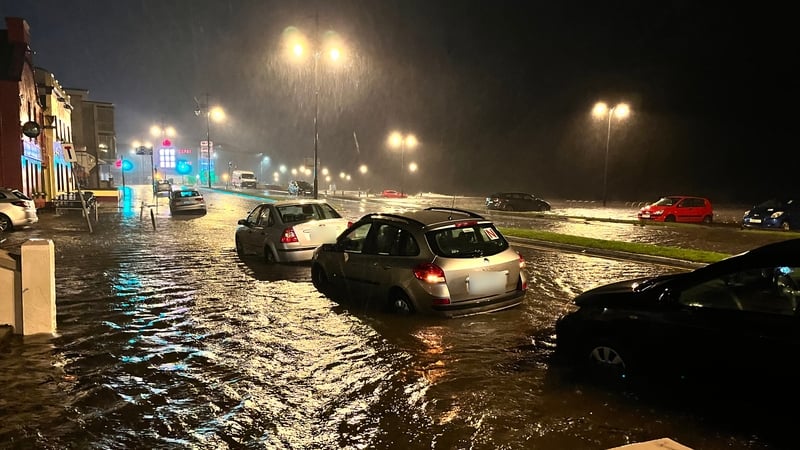Analysis: researchers are working on a robust flood alarm system using data and technology to alert authorities to potential flooding in local areas
We've all had the experience of seeing weather warnings, whether yellow, orange or red, issued for our county and wondering about them. What does that mean for me? How seriously should I take this? And what, if any, actions should I take in response?'
These questions become all the more critical for the growing number of us living in places at risk of flooding. Recent events have highlighted again the damage and personal devastation that flooding can bring to affected communities. As the risks from flooding rise due to the effects of a warming planet, there is an urgent need to improve how we anticipate, plan for, and manage flood risk at a local level in Ireland.
This is the genesis of our new research project StopFloods4.ie. We are investigating ways to bridge the gap from national or county level forecast information to local-level decision making, with the aim of reducing the losses from flooding and ultimately building community resilience to flooding.
We need your consent to load this rte-player contentWe use rte-player to manage extra content that can set cookies on your device and collect data about your activity. Please review their details and accept them to load the content.Manage Preferences
From RTÉ Radio 1's News At One, Londis Clarinbridge's Ronan Hennigan and Fianna Fáil councillor Martina Kinane on Storm Debi floods in Co Galway
Weather forecasting services are hugely valuable. Whether that’s for planning military operations, making critical decisions in weather-dependent industries (construction, farming, fishing, electricity generation) or simply deciding if now is a good time to put the clothes on the line, being able to predict the weather has enormous social and economic benefits. As I’m writing this, I notice it’s started raining again, so I check the weather app on my phone to see if I can time my cycle home from work to avoid the rain.
Huge strides have been made in recent decades in our ability to forecast the weather, thanks to investment and research effort over time. This is combined with advances in technology that allow more precise observation of the weather, and increasingly realistic and detailed simulation of weather patterns using models that run on super-computers.
We need your consent to load this rte-player contentWe use rte-player to manage extra content that can set cookies on your device and collect data about your activity. Please review their details and accept them to load the content.Manage Preferences
From RTÉ Radio 1's Today with Claire Byrne, Met Eireann Forecaster, Andrew Doran Sherlock on weather warnings as a result of Storm Ciarán
But forecasting the weather remains extremely difficult, given the chaotic nature of weather systems. When it comes to predicting flooding, things get even more complicated. Flooding is a particularly difficult phenomenon to forecast, as it depends on a multitude of factors. The primary driver is of course rainfall. Rainfall is itself difficult to forecast at a local scale and with advance notice. But flooding at a given location often depends on rainfall occurring elsewhere – for example, across a river catchment – and how that water then moves through the landscape (both natural and built) to arrive at a given point.
Numerous additional factors can contribute to the likelihood and intensity of flooding, including tide heights, storm surges and wave action on the coast, which depend in part on wind speed and direction, as well as river levels and soil moisture, which depend on recent rainfall. There is also human interventions such as the erection of flood barriers, the operation and maintenance of storm drains and sewers and, perhaps most consequentially, the operation of dams.
Risk managers at a local level (typically in local authorities) in Ireland have developed expertise over time in anticipating and managing flood risk, based on the prevailing conditions and experience of past flood events. However, their jobs are complicated by the range of data sources that need to be consulted. What’s worse, climate change is altering the profile of flood risk, meaning that historical experience won’t always provide a good guide to future flooding.
We need your consent to load this rte-player contentWe use rte-player to manage extra content that can set cookies on your device and collect data about your activity. Please review their details and accept them to load the content.Manage Preferences
From RTÉ Radio 1's Morning Ireland, Eoin Sherlock from Met Éireann on the weather warnings issued to local authorities and the public ahead of Storm Babet in October
When Met Eireann issues a weather warning, typically on a county-by-county basis, this alerts local authorities and others to potentially hazardous weather conditions. Risk managers then need to translate the forecast information to the local level. This typically involves combining forecast information for rainfall, wind speed and direction, with a range of additional data coming from multiple sources, such as tide tables (heights), storm surge models, as well as real-time data on river levels and rainfall.
Additional factors such as on the ground conditions including soil saturation and local vulnerabilities might also be taken into account to arrive at a judgment on the likelihood of experiencing flooding at any given location, where is likely to be worst affected, and what actions should be taken in anticipation.
StopFloods4.ie is a collaboration between engineers, data scientists and economists at the University of Galway working closely with Met Eireann and the OPW as well as a number of local authorities around the country. We are investigating ways to support local decision makers to access decision relevant data at the local scale in a timely and consistent way. We see huge potential in using the latest technology, including machine learning methods and big data, to develop decision support tools that will help local authorities to integrate data coming from multiple sources, and importantly to translate that data to local conditions.
We need your consent to load this rte-player contentWe use rte-player to manage extra content that can set cookies on your device and collect data about your activity. Please review their details and accept them to load the content.Manage Preferences
From RTÉ Radio 1's The Business, Midleton estate agent Adrianna Hegarty on how the recent flooding in the town has impacted on local businesses
Our solution will involve state-of-the-art flood modelling to generate high resolution simulations of flooding for our test site of Cork city. These models will integrate flood risk information from individual drivers (coasts, rivers and rainfall) to account for the complex interactions between these drivers of flood risk. Compound flood events, where risks from coasts, rivers and rain coincide, are expected to become more frequent and severe. These events typically involve amplified risks and flood impacts, as we saw in the recent flooding in Midleton, where heavy rainfall fell on already saturated ground and happened to coincide with a high tide.
This local-scale flood modelling will be combined with advances in artificial intelligence and big data streams to develop an automated system for predicting flood likelihood at a given location, based on the prevailing and forecast conditions. The system will draw on real-time data from weather buoys, rain and river gauges, as well as information from weather forecasts. It will be trained on data from historical flood events, and tested against the predictions from physical flood models.
If the system ultimately proves to have predictive power, it can be run in parallel to existing methods and made available as a decision support tool for local authorities to complement their existing practices and expertise. The aim is to develop a robust flood alarm system that will alert local authorities to potential flooding at the local scale, so resources can be allocated, warnings issued to residents and business owners and properties and lives protected.
We need your consent to load this rte-player contentWe use rte-player to manage extra content that can set cookies on your device and collect data about your activity. Please review their details and accept them to load the content.Manage Preferences
From RTÉ Radio 1's News At One in Aug 2023, Emily Young of Save Our Shannon Organisation on the 75,000 acres of farmland in The Callows in Co Offaly which is now under water
The big picture here is that flood risk is getting worse due to climate change. Floods are already the costliest and most pervasive natural hazard globally. In the absence of sustained policy effort, we can expect the costs from flooding to escalate rapidly over the coming years and decades.
The good news is that public investments work - and we all know that prevention is better than cure. When it comes to flooding, prevention requires a coordinated policy response on multiple fronts. First and foremost, we need to limit global warming by rapidly transitioning to a low carbon economy, and persuading our international friends and partners to do likewise. This will ensure our capacities to cope with extreme weather conditions are not overwhelmed by the scale of the changes we will face.
The second part is to invest in adaptation to cope with the local effects of a changing climate. That includes avoiding the development of flood plains, investing in flood defences and in the provision of information on risks, and investment in community level preparedness, including emergency planning and management at a local level, and involving communities in this work, in order to build community resilience. We hope that our project can contribute to addressing this important societal challenge.
The StopFloods4.ie project is funded by SFI and is led by Dr Indiana Olbert, Dr Tom McDermott and Dr Martin Serrano at the University of Galway. To find out more about the project, please get in touch by email on stopfloods@universityofgalway.ie
The views expressed here are those of the author and do not represent or reflect the views of RTÉ





